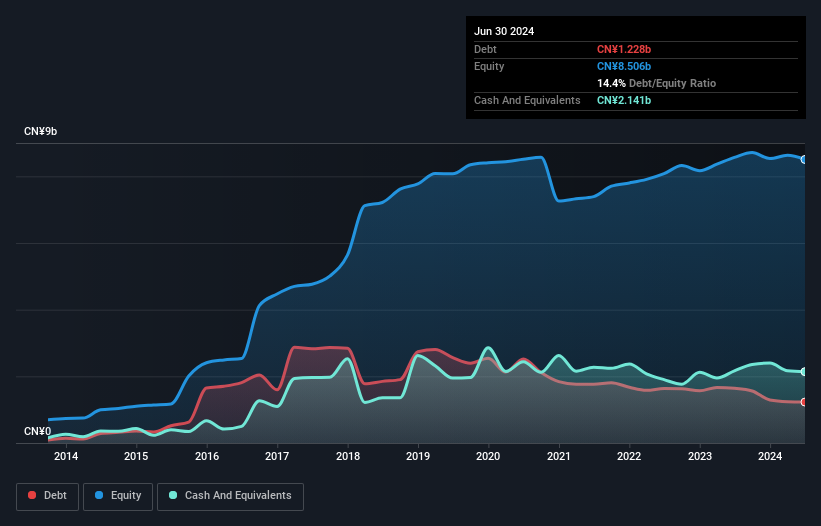- China
- /
- Electronic Equipment and Components
- /
- SZSE:300296
These 4 Measures Indicate That Leyard Optoelectronic (SZSE:300296) Is Using Debt Reasonably Well
The external fund manager backed by Berkshire Hathaway's Charlie Munger, Li Lu, makes no bones about it when he says 'The biggest investment risk is not the volatility of prices, but whether you will suffer a permanent loss of capital.' It's only natural to consider a company's balance sheet when you examine how risky it is, since debt is often involved when a business collapses. As with many other companies Leyard Optoelectronic Co., Ltd. (SZSE:300296) makes use of debt. But is this debt a concern to shareholders?
What Risk Does Debt Bring?
Debt assists a business until the business has trouble paying it off, either with new capital or with free cash flow. Ultimately, if the company can't fulfill its legal obligations to repay debt, shareholders could walk away with nothing. However, a more usual (but still expensive) situation is where a company must dilute shareholders at a cheap share price simply to get debt under control. Of course, the upside of debt is that it often represents cheap capital, especially when it replaces dilution in a company with the ability to reinvest at high rates of return. The first thing to do when considering how much debt a business uses is to look at its cash and debt together.
Check out our latest analysis for Leyard Optoelectronic
How Much Debt Does Leyard Optoelectronic Carry?
You can click the graphic below for the historical numbers, but it shows that Leyard Optoelectronic had CN¥1.23b of debt in June 2024, down from CN¥1.64b, one year before. However, its balance sheet shows it holds CN¥2.14b in cash, so it actually has CN¥912.5m net cash.

How Strong Is Leyard Optoelectronic's Balance Sheet?
The latest balance sheet data shows that Leyard Optoelectronic had liabilities of CN¥4.50b due within a year, and liabilities of CN¥1.33b falling due after that. Offsetting this, it had CN¥2.14b in cash and CN¥5.11b in receivables that were due within 12 months. So it actually has CN¥1.43b more liquid assets than total liabilities.
This surplus suggests that Leyard Optoelectronic has a conservative balance sheet, and could probably eliminate its debt without much difficulty. Simply put, the fact that Leyard Optoelectronic has more cash than debt is arguably a good indication that it can manage its debt safely.
It is just as well that Leyard Optoelectronic's load is not too heavy, because its EBIT was down 81% over the last year. When it comes to paying off debt, falling earnings are no more useful than sugary sodas are for your health. There's no doubt that we learn most about debt from the balance sheet. But ultimately the future profitability of the business will decide if Leyard Optoelectronic can strengthen its balance sheet over time. So if you're focused on the future you can check out this free report showing analyst profit forecasts.
Finally, while the tax-man may adore accounting profits, lenders only accept cold hard cash. While Leyard Optoelectronic has net cash on its balance sheet, it's still worth taking a look at its ability to convert earnings before interest and tax (EBIT) to free cash flow, to help us understand how quickly it is building (or eroding) that cash balance. Over the most recent three years, Leyard Optoelectronic recorded free cash flow worth 78% of its EBIT, which is around normal, given free cash flow excludes interest and tax. This free cash flow puts the company in a good position to pay down debt, when appropriate.
Summing Up
While it is always sensible to investigate a company's debt, in this case Leyard Optoelectronic has CN¥912.5m in net cash and a decent-looking balance sheet. The cherry on top was that in converted 78% of that EBIT to free cash flow, bringing in CN¥670m. So we don't have any problem with Leyard Optoelectronic's use of debt. There's no doubt that we learn most about debt from the balance sheet. However, not all investment risk resides within the balance sheet - far from it. We've identified 3 warning signs with Leyard Optoelectronic , and understanding them should be part of your investment process.
If you're interested in investing in businesses that can grow profits without the burden of debt, then check out this free list of growing businesses that have net cash on the balance sheet.
New: AI Stock Screener & Alerts
Our new AI Stock Screener scans the market every day to uncover opportunities.
• Dividend Powerhouses (3%+ Yield)
• Undervalued Small Caps with Insider Buying
• High growth Tech and AI Companies
Or build your own from over 50 metrics.
Have feedback on this article? Concerned about the content? Get in touch with us directly. Alternatively, email editorial-team (at) simplywallst.com.
This article by Simply Wall St is general in nature. We provide commentary based on historical data and analyst forecasts only using an unbiased methodology and our articles are not intended to be financial advice. It does not constitute a recommendation to buy or sell any stock, and does not take account of your objectives, or your financial situation. We aim to bring you long-term focused analysis driven by fundamental data. Note that our analysis may not factor in the latest price-sensitive company announcements or qualitative material. Simply Wall St has no position in any stocks mentioned.
About SZSE:300296
Leyard Optoelectronic
Operates as an audio-visual technology company in China and internationally.
Excellent balance sheet and fair value.
Similar Companies
Market Insights
Community Narratives



